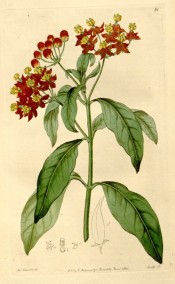Asclepias curassavica L.
Frost tender, evergreen sub-shrub, often grown as an annual, with upright branches and lance-shaped leaves, and axillary, umbel-like cymes of red or orange-red flowers, with orange-yellow hoods, from summer to autumn. To 1m. There is also a white-flowered form. [RHSE, Hortus].
Horticultural & Botanical History
‘The seed, buoyed by a silky plume, is wafted far and near like that of our thistles, like that it attaches itself to whatever it meets in its course, and separates at last from the plume which has suspended it, to seek the soil and germinate: proving by this habit a troublesome weed. Even in our hothouses, where it seeds freely. an inconvenience is perceived in as far as the other plants are disfigured by the downy seed. […] Cultivated in 1692 in the Hampton Court Garden.’ [BR f.81/1816]. Loddiges’ Botanical Cabinet figures Asclepias salicifolia Lodd., which is probably A. currasavica alba. ‘It is not exactly known of what country it is a native: it produced its delicate white flowers in our stove at least four months during the summer and autumn: they have a very agreeable smell.’ [LBC no.272, 1818] Asclepias curassavica is also figured. [LBC no.349/1819]. ‘Your ipecacuanha plant is Asclepias curassavica, an emetic no doubt, but not at all like the Ipecacuanha of the shops.’ [Gard. Chron. 1841]. On the same topic Don wrote: ‘The roots have been sent to England as Ipecacuanha. The juice of the plant, made into a syrup, is said to be a powerful anthelmintic; it is given to children in the West Indies, for that purpose, from a tea- to a table-spoonful. The root, dried and reduced to powder, is frequently used by the Negroes as an emetic and hence its name of Wild or Bastard Ipecacuhana.’ [Don].
History at Camden Park
Listed only in the 1857 catalogue [T.70/1857]. Sent from Tahitit by Bidwill probably in late 1845. Macarthur wrote on 7th August 1846: ‘Of the first batch [of seeds sent] not a native Tahitian seed vegetated. The Hibiscus moschato-speciosus, Ascelias curassavica and Carica however came up well and are doing well.’ [MP A2933-2, p.189]. Plants were presented to the Sydney Botanic Garden on October 24th 1846 [RBGS AB]. It is now firmly established as a weed throughout tropical climes. Although it self-seeds quite readily in Camden it does not spread readily and is is not a significant weed in the area. I have not seen it at Camden Park. PlantNET describes it as ‘common in disturbed sites, chiefly north of the Manning River, also in the Sydney district’.
Notes
Asclepias curassavica Lour. (1790) = Toxocarpus wightianus Hook. And Arn., a Himalayan species.
Asclepias curassavica Griseb. (1874) = Asclepias campestris of either Vellozo or Decaisne.
Published Feb 26, 2009 - 02:52 PM | Last updated Jul 14, 2010 - 02:47 PM
| Family | Asclepiadaceae |
|---|---|
| Category | |
| Region of origin | South America |
| Synonyms | |
| Common Name | Blood flower, Indian root, Swallow-wort |
| Name in the Camden Park Record | Asclepias Curasavicus |
| Confidence level | high |


